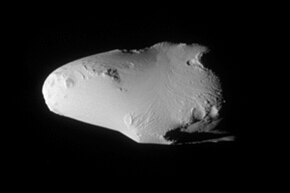 Calypso image from Cassini (February 13, 2010) | |
| Discovery | |
|---|---|
| Discovered by |
|
| Discovery date | March 13, 1980 |
| Designations | |
Designation | Saturn XIV |
| Pronunciation | /kəˈlɪpsoʊ/[1] |
Named after | Καλυψώ Kalypsō |
| Tethys C S/1980 S 25 | |
| Adjectives | Calypsoan /kælɪpˈsoʊ.ən/,[2] Calypsonian /kælɪpˈsoʊniən/[3] |
| Orbital characteristics | |
| 295000 km[4] | |
| Eccentricity | 0.001[4] |
| 1.887803 d[4] | |
| Inclination | 1.56° (to Saturn's equator) |
| Satellite of | Saturn |
| Group | L5 Tethys trojan |
| Physical characteristics | |
| Dimensions | 29.4 × 18.6 × 12.8 km (± 0.6 × 1.8 × 0.6 km)[5]: 2 |
| 19.0±0.8 km[5]: 2 | |
| Volume | 3591 km3[a] |
| Mass | ≈ 2×1015 kg (assumed; unmeasured)[b] |
Mean density | ≈ 0.5 g/cm3 (assumed; unmeasured)[5]: 3 |
| ≈ 0.0009–0.0013 m/s2[5]: 3 | |
| ≈ 0.004 km/s at longest axis to ≈ 0.006 km/s at poles | |
| synchronous | |
| zero | |
| Albedo | 1.34±0.10 (geometric) [6] |
Calypso is a moon of Saturn. It was discovered in 1980, from ground-based observations, by Dan Pascu, P. Kenneth Seidelmann, William A. Baum, and Douglas G. Currie, and was provisionally designated S/1980 S 25 (the 25th satellite of Saturn discovered in 1980).[7] Several other apparitions of it were recorded in the following months: S/1980 S 29, S/1980 S 30,[8] S/1980 S 32,[9] and S/1981 S 2.[10] In 1983 it was officially named after Calypso of Greek mythology.[c] It is also designated Saturn XIV or Tethys C.
Calypso is co-orbital with the moon Tethys, and resides in Tethys' trailing Lagrangian point (L5), 60 degrees behind Tethys. This relationship was first identified by Seidelmann et al. in 1981.[11] The moon Telesto resides in the other (leading) Lagrangian point of Tethys, 60 degrees in the other direction from Tethys. Calypso and Telesto have been termed "Tethys trojans", by analogy to the trojan asteroids, and are half of the four presently known trojan moons.
Like many other small Saturnian moons and small asteroids, Calypso is irregularly shaped, has overlapping large craters, and appears to also have loose surface material capable of smoothing the craters' appearance. Its surface is one of the most reflective (at visual wavelengths) in the Solar System, with a visual geometric albedo of 1.34.[6] This very high albedo is the result of the sandblasting of particles from Saturn's E-ring, a faint ring composed of small, water-ice particles generated by Enceladus' south polar geysers.[12]
- ^ "Calypso". Lexico UK English Dictionary. Oxford University Press. Archived from the original on March 22, 2020.
- ^ The Emerson Society Quarterly, vol. 50, p. 56, 1968
- ^ "Calypsonian". Lexico UK English Dictionary UK English Dictionary. Oxford University Press. Archived from the original on March 22, 2020.
- ^ a b c Cite error: The named reference
jpl-satelemwas invoked but never defined (see the help page). - ^ a b c d e Thomas & Helfenstein 2020.
- ^ a b Verbiscer French et al. 2007.
- ^ IAUC 3496.
- ^ IAUC 3549.
- ^ IAUC 3605.
- ^ IAUC 3593.
- ^ Seidelmann Harrington et al. 1981.
- ^ Mason 2010.
Cite error: There are <ref group=lower-alpha> tags or {{efn}} templates on this page, but the references will not show without a {{reflist|group=lower-alpha}} template or {{notelist}} template (see the help page).